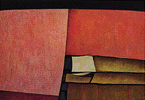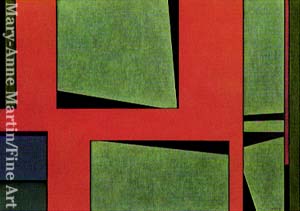Gunther Gerzso
80th Birthday Show
|
 |
|
Gunther Gerzso
Dore Ashton
|
|
| page 1 | page 2 | page 3 | page 4 |
|
|
I think Traba
was right to see landscape as the central motif in Gerzso's life's work, and
specifically, the Mexican landscape. His work as set designer for over two
hundred Mexican films brought him to survey the entire country with an eye
to wresting from the panorama a telling abstraction. Yet, this is a landscape
of the mind, through which flows so many elements, not the least, the human
image. Metamorphosis, another Surrealist value raised to the highest degree,
plays its part in each of Gerzso's paintings. So do ambiguities, and secrets,
that all writers on his work have felt reside behind the hard, luminous
picture plane. Take only one of his paintings and linger with it: Landscape,
Orange-Green-Blue of 1982.
We are confronted with a vast but bounded field
of orange (not entirely opaque however-there are yellow and ocher undertones
and flecks of ocher making the final plane vibrate). This field is, as are many
fields in Gerzso's paintings, not only a field but a wall and also a curtain as
might exist on the stage of an avant-garde drama. Within the field are four
unattached lines, each with a nimbus, each as frail as a comma, and each
providing the painting with a different scale. Now scale, as every painter
knows, is a difficult problem. It is not just a matter of large and small. It
must incur mysterious relationships. Klee never spoke of scale in itself.
Rather, he spoke of "measuring and weighing." One can measure and weigh the
plane of orange only as one measures the weightlessness of these threads of
line. And temporality, as Klee insisted, enters. The time the eye takes to
scan the plane is measured in terms of the fragile commencement in the line.
In this painting, as in many other recent paintings, Gerzso has again invoked
the special qualities of line which can at once describe the final boundary of
a form and suggest the life of the form behind. The shaded line, the swelling
line, the diminishing line, the hairfine line serve him both to illuminate the
character of his planar forms and to suggest mystery and depth. A pair of
blue bars, overriding the orange plane in this painting are separated from it
by delicate dark lines. These two blue bars, as musical as any of Klee's, set
off another set of juxtapositions, and another, as the
horizontal planes pass into infinity.
But it is not only a matter of the
surprising juxtaposition of planes in different scales. Here, and I think in
most of Gerzso's paintings, there is a specific surreal emphasis. The three
dappled blue shapes, roughly rectangular, that ride on the very surface of the
painting, are, in fact, windows, and the cool blue is nothing other than a
Magritte-like allusion to sky. Glass, reflection, sky, boundaries, houses,
inside, outside-how many associations does he not compress in this intense
abstract painting by means of these unexpected illusions of the real. The
cracked, window-like shape has existed in many of Gerzso's paintings,
including works as long ago as 1965, and can be compared to other shapes in
his paintings in which there is a deliberate, slashing rent-symbol of broken
idols, shattered monuments, archaic memories of separation and even death.

23. Naranja-azul-verde, 1972
|
There are paintings that Gerzso has titled to refer us to the association with
ancient Mexico, and others where the shapes, so firmly trapezoidal or
rectilinear, inevitably evoke the architecture of the Mayans or the Aztecs.
But there are others in which he gives us the clue to the reading that he calls
"personage-landscape" (in Spanish it has its implicit poetic elision:
personaje-paisaje). These are paintings in which the personage, as would a
character in the theater, is all but hidden behind the coulisses. It is a
presence. It exists in a vertical clatter of planar infinity, or on the vast
plateau of Mexico, but always reticent, always masked. This personage is
certainly Gerzso, who has diffused himself throughout his paintings, with
only a few, but very telling clues to his physical being as a man. The process
of masking; of layering memory (does he not call one of his paintings Ancient
Abode, and suggest the living presence of himself and all others?) is carried
out with a painter's rigor. Each plane secretes another. Each color makes
another shine. Each line has its opposite. Everything in the world is firmly
compressed. And behind, the vivid presence of the eye that discerns, that
extends. Gerzso is certainly Gerzso and nothing else.
|
|






|











